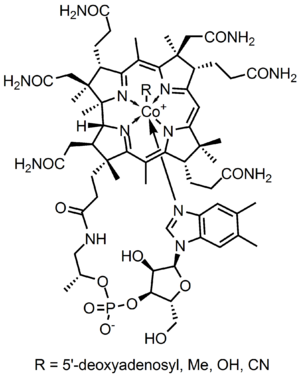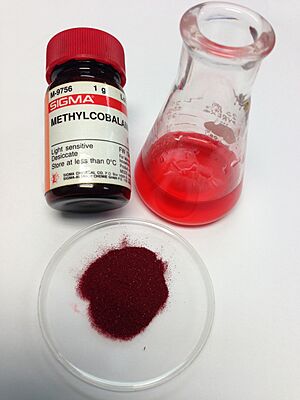Vitamin B12 facts for kids
Vitamin B12, also known as cobalamin, is a super important vitamin. It helps your brain and nervous system work well. It also helps your body make healthy blood. Vitamin B12 is one of eight different B vitamins.
Every cell in your body needs B12 to work properly. It helps make DNA, which is like the instruction manual for your cells. It also helps your body use fats and proteins.
Contents
What is Vitamin B12?
Vitamin B12 is a special group of compounds. They all act like vitamins in your body. This vitamin is the largest and most complex vitamin we know! It's unique because it contains a rare element called cobalt. This cobalt sits right in the middle of a ring-shaped structure called a corrin ring.
Your body can change the B12 you get from food into the exact forms it needs to use.
Where Does Vitamin B12 Come From?
Here's a cool fact: Fungi, plants, and animals (including humans) cannot make vitamin B12 themselves! Only tiny living things like bacteria and archaea have the special tools (called enzymes) to create it.
So, how do we get it? Many foods naturally have B12 because of a special partnership with bacteria. For example, some bacteria live in the guts of plant-eating animals (herbivores). These bacteria make B12. When meat-eating animals (carnivores) eat herbivores, they get the B12. Plants and algae can also get it from bacteria they live with. So, no matter what, animals get vitamin B12 from bacteria!
Because only bacteria can make it, vitamin B12 is produced for medicines and supplements using a special process called bacterial fermentation.
Why is Vitamin B12 Important?
Scientists first found vitamin B12 because it was linked to a condition called pernicious anemia. This is a type of autoimmune disease where your body has trouble absorbing B12. To absorb B12, your stomach needs to make something called an "intrinsic factor." If you don't have enough of this factor, your body can't take in the B12, leading to a vitamin B12 deficiency. Since then, doctors have found many other reasons why people might not have enough vitamin B12.
Images for kids
See also
 In Spanish: Vitamina B12 para niños
In Spanish: Vitamina B12 para niños




